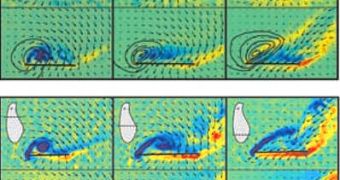When the right time comes, maple seed pods separate from their trees, and, as any other seeds, start their journey to nearby regions, where they take root and give birth to new maples. But, in this case, the apple, indeed, falls far from the tree. In a new series of experiments, researchers have demonstrated that, because of their shapes, these seeds travel for miles around, carried on small vortices they themselves generate through their spin. The vortices are very similar in appearance to tornadoes, and they have been evidenced by high-speed cameras and colored smoke.
The seeds are shaped like elongated pods, with one end densely packed with seeds. On account of this configuration, they rotate when they fall, creating lift at the same time. All of this happens because the movement of the “propeller” creates an area of low air pressure above the seed, by sucking the air towards it. This, in turn, generates lift, which allows the spinning seed to remain aloft for long distances, and to fly on its own when there is no wind to carry it.
The vortices, discovered by David Lentink of the Washington University, form at the extremities of the seeds, and, apparently, have the ability to significantly influence the air above. In their experiments, the WU team created large-scale plastic models of whirlybirds, the popular name for the pods. They made them fly in a solution containing glass beads suspended in oil, which was lit by lasers. The vortices could be easily identified using high-speed cameras, and the entire process slowed down to a near stand-still for a video.
After the models were used, Lentink threw real-life maple seeds through colored smoke, and noticed that the tornado-like vortices appeared as well, naturally on a smaller scale. The methodology used in the experiments was detailed in the Thursday issue of the journal Science, Wired reports. The investigation revealed the fact that the pods were two times more efficient and aerodynamic than any helicopter or fixed wing design created by man. Lentink said that the shape might be “a convergent aerodynamic solution in the evolution of flight performance in both animals and plants.”
After the results are refined, they could be used to create such things as parachute systems for future robotic missions on other planets. Relying on parachutes does have its perks, but a whirlybird system would be far more efficient, researchers say. Micro-helicopters could also employ the new technology, which relies on the newly found vortices. Bats and some insects were also discovered to generate the same kind of air disturbance as maple seeds.

 14 DAY TRIAL //
14 DAY TRIAL //